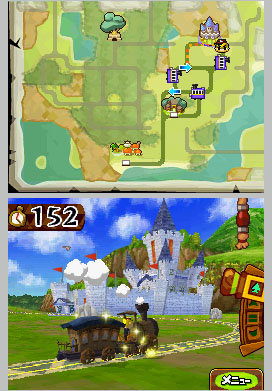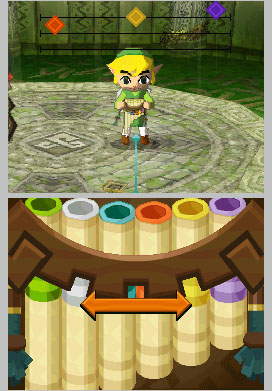
Spirit Tracks is designed as a follow-up to the last DS release for the Zelda series, Phantom Hourglass. You'll see a few returning motifs, and the art style is similarly evolved from Wind Waker, but it's not really a direct sequel, as it again resets to new, young versions of Link and Zelda. The story has Link traveling the world as he attempts to stop the resurrection of Malladus, the demon king, but he won't do it alone. After the basic visit to the castle and requisite annoying stealth sequence, Zelda's body is stolen, and is to be used as a vessel for the returning antagonist. This leaves Zelda's spirit roaming free, in ghost form. So she tags along with Link for the duration of the game, popping out occasionally to provide some tips about what you're supposed to be doing.
Zelda also takes a more active role in some parts of the game. The basic flow of Spirit Tracks has you visiting the Tower of Spirits, a tall building in the center of the world, to get maps to the game's four quadrants. Once you've acquired the map, you can head out into one of the game's four realms, each with its own points of interest, including a temple. Those temples are very much done in the traditional Zelda style, with a new inventory item that you'll obviously use on that temple's boss. But the levels you'll take on in the tower have a very different feel to them, and focus much more on puzzle-solving than combat. In the tower, Zelda can possess Phantoms--which are large, ghostly sets of armor that roam the halls of the tower and effectively wipe you out in one hit, making careful play a requirement. Once in a suit of armor, you can directly control Zelda's ghost by tapping a circle at her feet and drawing a path for her to move along. The different suits she'll possess as you return to the tower every couple of hours give her slightly different abilities, which changes up how you'll forge ahead.

Though you can use the DS face buttons and triggers as handy shortcuts for some functions, Spirit Tracks is primarily played with the stylus. You'll tap enemies to attack, hold the stylus on the screen to move in different directions, and make helpful notes on maps. You'll also draw flight paths for boomerangs, and swipe or swirl on the screen to perform different sword moves. For the most part, the stylus control is great, and gives the entire game a sort of laid-back, simple feel. But in the few cases where the game starts demanding precision, all of that stylus control becomes something of a liability. Things like a boss fight where you have to quickly use the boomerang to bring fire to an icy enemy, or having to deflect incoming projectiles with well-timed sword swings were more frustrating than fun, because it's easy to see exactly what you need to do, it's just not always as easy to do it. Not to totally discount the nature of stylus controls, but if you could swing the sword by pushing a button and move yourself around with some sort of "directional pad," this wouldn't be an issue at all. Thankfully, most of the game is pretty forgiving with this sort of thing.
There are a lot of little side things to do in Spirit Tracks, like the occasional passenger who wants to get from one place to another, or the rabbit rescue guy, who gives you cash and bonuses for finding and delivering any wild rabbits you find while chugging around the world. You can even upgrade your train with sturdier cars, which is sort of handy during one late-game sequence. But I never ran into any situation that would have been much easier with a few extra heart containers, and only really died when I got extremely careless. Most of the challenge in Spirit Tracks comes from staring at maps and figuring out what, exactly, needs to be done to get from point A to point B.

The audio is what you'd expect, with remixed takes on the franchise's anthemic soundtrack and plenty of yelps and shouts (but no speech) from Link. Visually, the game looks very similar to Phantom Hourglass, keeping to the Wind Waker style that served the previous game so well. Though Link is understandably silent, his eyes and mouth are able to convey a good range of emotions, from fear to joy to gritted determination. Artistically, the game looks fantastic. On the technical side, though, the game noticeably slows down when you're attacked while on your train. It makes an already slow process feel even slower.
Though parts of Spirit Tracks are a little disappointing, most of those low points are offset by its terrific puzzle design and a great, fun story that feels noticeably different from the standard "save the princess" saga that series fans are used to seeing. Plus you can blow the train whistle, at will, whenever you're on-board. That's gotta count for something, right?